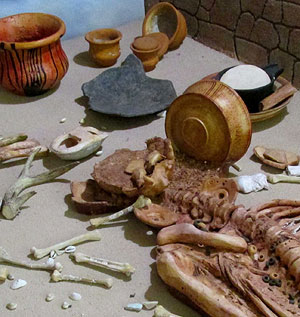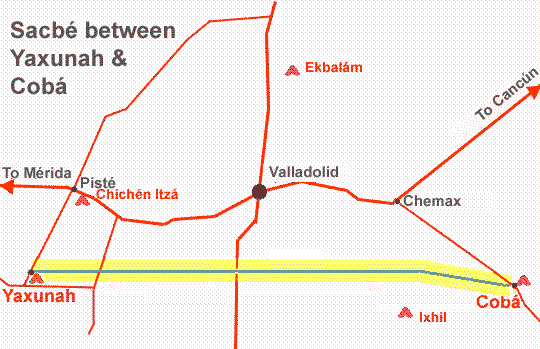Around 4000 years ago, south of the Yucatan Peninsula, in the general area of Guatemala, Honduras and
Chiapas, a culture arose displaying what nowadays we think of as distinctive Maya
features. Current thinking is that the first Maya inhabitants settled at Yaxunah between 2750 and 2500 years ago -- well over a thousand years
after Maya civilization arose farther south. Here are major events in the history of the
Maya at Yaxunah:
- 750/500 B.C.: first indications of people living at Yaxunah
- between 400 and 500 A.D., Yaxunah's royal family is murdered and thrown
haphazardly into the tomb now known as Burial B
- around 600 A.D.: Cobá takes control of Yaxunah and somewhat later the
100-kms-long elevated road, or sacbé, is built between Yaxunah and Cobá
- ± 1050-1150 A.D.: Chichén Itzá conquers Yaxunah
- after Chichén Itzá conquers Yaxunah, the population plummets and the site is gradually
abandoned
To the people of Yaxunah, each of these events had profound
effects, as discussed below:
YAXUNAH'S FIRST
INHABITANTS
Based on pottery fragments excavated at Yaxunah, a good guess is that around 750 to
500 B.C. the people who first settled Yaxunah came from Belize and/or Guatemala's southern
Petén area.
The oldest buildings at Yaxunah are situated along a north-south axis,
suggesting that the structures were built for ceremonial purposes, probably for ancestor worship. Usually such temples are built only when there's
an elite group within a population, such as a royal family.
 The museum in Yaxunah's Community Center
features a reproduction of a burial from this early time, excavated at Yaxunah ruins. The
burial appears to be of an important person, maybe a king. Objects found in the tomb
indicate that he had been an important person buried with care, and that he had been made
ready for his journey into the afterworld. Not much more is known about this burial. You
can see part of the burial's reproduction at the left.
The museum in Yaxunah's Community Center
features a reproduction of a burial from this early time, excavated at Yaxunah ruins. The
burial appears to be of an important person, maybe a king. Objects found in the tomb
indicate that he had been an important person buried with care, and that he had been made
ready for his journey into the afterworld. Not much more is known about this burial. You
can see part of the burial's reproduction at the left.
Yaxunah's early pottery style slowly evolved and then stayed the same, and
the population continued to grow, until around A.D. 400. That suggests that during this
time no successful invasions from the outside took place at Yaxunah.
BURIAL B
POTTERY FRAGMENTS
The main archaeological evidence for establishing dates for discoveries at Yaxunah site
comes from pottery fragments. Different cultures at different times in their histories
produce distinctive pottery. Oftentimes a pottery expert can look at a piece of pottery
and say where it came from and how old it is .One feature of pottery dating is, "
the
deeper in the ground it's buried, the older it is relative to what's above it."
Of course the ground must be undisturbed for this dating method to be used. When looters
shovel up the ground, they destroy critically important information. Below you can see
ancient pottery fragments picked up in the streets and yards of Yaxunah, on display in the
Yaxunah Community Center museum.

To date, the most spectacular discovery at Yaxunah is Burial B --
also called Burial 24 or Tomb 24 -- dated between 400 and 500 A.D.
The burial holds the remains of eleven men, women and children, apparently Yaxunah's royal
family who appeared to have been tortured and publically killed. The king's head had
been removed, and the bodies appear to have been thrown into the tomb haphazardly. This
and objects left in the burial were to make the point that the old dynasty had ended and
that a new one was being established.
Evidence at Burial B suggests that the people who killed the royal family
had knowledge that only someone close to the royal family would have known. Perhaps those
who took power were cousins of the royal family. Much mystery still surrounds the dramatic
events relating to Burial B.
Pottery fragments indicate that up to this point in Yaxunah's history,
Yaxunah maintained strong ties with other Maya settlements, mostly with the traditional
Maya homeland to the south. The people who killed the royal family in Burial B didn't
maintain these contacts. After the power change, pottery from Ek Balam to the north
appeared. Most construction ended at Yaxunah, but the little that did occur used local
sources. After the royal family was killed and dumped in Burial B, then, Yaxunah society
seems to have suffered a certain isolation and impoverishment.
YAXUNAH DOMINATED
BY COBÁ
Around A.D. 600, Cobá, 100 kilometers to the east, violently took
control of Yaxunah. Now Yaxunah's population dramatically increased and robust building
began again. Surely the most impressive construction at this time was the Maya world's
longest elevated road, or sacbé, built between Yaxunah and Cobá. The
remarkable scale of that sacbé is shown below:
ARCHEOLOGICAL
PUBLICATIONS
ON FILE IN THE LIBRARY AT
YAXUNAH COMMUNITY CENTER
Numerous papers are available but these are the most important:
Ardren, Traci Ann. 1997. "The Politics of Place: Architecture and Cultural
Change at the Xkanha Group, Yaxuna, Yucatan, Mexico." Unpublished Ph.D.
dissertation, Department of Anthropology, Yale University, New Haven.
Johnstone, Dave. "The Ceramics of Yaxuna." Unpublished Ph.D.
dissertation, Department of Anthropology, Southern Methodist University, Dallas.
Stanton, Travis W. 2000. "Heterarchy, Hierarchy, and the Emergence of the
Lowland Maya: A Study of Complexity at Yaxuna, Yucatan, Mexico (400-B.C.-- A.D. 600."
Ph. D. dissertation, Department of Anthropology, Southern Methodist University, Dallas.
Stanton, Travis W. David A. Freidel, Charles K. Suhler, Traci Ardren, James N.
Ambrosino, Justine M. Shaw and Sharon Bennett. 2010. Archaelogical
Investigation at Yaxuná, 1986-1996 Results of the Selz Foundation Yaxuna Project.
Bar International Series 2056, Archaeopress, Oxford, England
Toscano, Hernández, Lourdes, Diana Trejo Torres, Luis Cabrera Paredes, Gustavo Novelo
Rincon. 1998. "Proyecto Yaxuná: Investigación y Restauración
Arquitectónica en el Grupo del Juego de Pelota Informe de la Temporada 1997-98."
Instituto Nacional de Antropología y Historica Centro INAH Yucatán. Yucatán, Mérida.
Despite the obvious importance of these events, archaeologists find
it hard to agree on the story of who did what to whom, and why. A good guess is that at
this time Cobá was competing for power in the Peninsula with other Maya kingdoms, and
obliged Yaxunah to be part of its military alliance. Later the city of Uxmal joined the
alliance. Probably this alliance was felt necessary because of the ever-growing power and
militaristic nature of Chichén Itzá only 20kms to the north.
Yaxunah's increased population may have come about through colonization
from Cobá and other cities in the alliance. Also, in the ancient heart of Maya power --
in Guatemala, Belize and Chiapas -- classic Maya society was "collapsing," with
great cities being abandoned. Maybe refugees from that still-unexplained event may have
worked their way north and settled at Yaxunah. Wherever they came from, the new settlers
built wherever they could find space, even in what earlier had been considered sacred
ground, so clearly Yaxunah's society changed dramatically with the occupation of Cobá.
YAXUNAH CONQUERED
BY CHICHÉN ITZÁ
By ± 900-950 A.D., Chichén Itzá had become so powerful that it conquered Yaxunah and
drove out Cobá-led forces.
Apparently Chichén Itzá had no interest in colonizing Yaxunah, for their
forces remained only briefly, maybe less than a year. This was probably because Chichén
Itzá had its own problems. Around 1200-1300 A.D. or so, Chichén Itzá itself was
conquered by people using pottery from Mayapan, the last significant Maya center of power.
With this defeat, Chichén Itzá lost much of its population and no longer remained a
force to deal with.
YAXUNAH "COLLAPSES"
After being conquered by Chichén Itzá, Yaxunah's population drastically diminished. Only a small number of Maya stayed in the area to farm, Sometimes pilgrims
would visit to conduct simple rituals there. This situation endured into colonial
times, and to some extent to this very day.
 The museum in Yaxunah's Community Center
features a reproduction of a burial from this early time, excavated at Yaxunah ruins. The
burial appears to be of an important person, maybe a king. Objects found in the tomb
indicate that he had been an important person buried with care, and that he had been made
ready for his journey into the afterworld. Not much more is known about this burial. You
can see part of the burial's reproduction at the left.
The museum in Yaxunah's Community Center
features a reproduction of a burial from this early time, excavated at Yaxunah ruins. The
burial appears to be of an important person, maybe a king. Objects found in the tomb
indicate that he had been an important person buried with care, and that he had been made
ready for his journey into the afterworld. Not much more is known about this burial. You
can see part of the burial's reproduction at the left.
